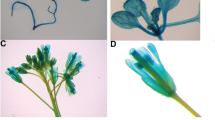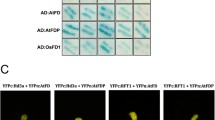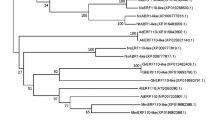Abstract
The molecular biology of flowering has been most extensively studied in the quantitative long-day plant Arabidopsis thaliana. The Arabidopsis LUMINIDEPENDENS (LD) gene encodes a potential transcriptional regulator that acts as a positive effector of flowering, at least in part through suppression of the floral inhibitor gene FLC. As an initial step to explore the conservation of the molecular mechanisms of flowering among plants of various flowering habits, and to further investigate the molecular action(s) of LD, we have identified a gene from maize (Zea mays) that is closely related to Arabidopsis LD. The major product of this gene, which we have designated ZmLD for Zea mays LUMINIDEPENDENS, contains four conserved regions that may constitute functionally important components of the LD proteins. One of these regions closely resembles the canonical homeodomain. The ZmLD gene exists as a single copy in the maize genome, and generates a major ca. 4.0 kb transcript, and a minor ca. 2.6 kb transcript that results from alternative transcriptional termination. The 4.0 kb ZmLDα transcript accumulated to highest levels in proliferative tissues, including the shoot apex and developing inflorescences. Expression of ZmLDα under control of the Arabidopsis LD promoter in transgenic Arabidopsis caused developmental defects similar to those conferred by loss-of-function mutations in a class of genes involved in maintaining the proliferative nature of the shoot, inflorescence, and floral meristems. These effects were not influenced markedly by the activities of the Arabidopsis LD or FLC genes. We consider the implications for the conservation of LD function between maize and Arabidopsis.
Similar content being viewed by others
References
Allen, P.B., Kwon, Y.-G., Nairn, A.C. and Greengard, P. 1998. Isolation and characterization of PNUTS, a putative protein phosphatase 1 nuclear targeting subunit. J. Biol. Chem. 273: 4089–4095.
Amasino, R.M. 1996. Control of flowering time in plants. Curr. Opin. Genet. Dev. 6: 480–487.
Aukerman, M.J., Lee, I., Weigel, D. and Amasino, R.M. 1999. The Arabidopsis flowering-time gene LUMINIDEPENDENS is expressed primarily in regions of cell proliferation and encodes a nuclear protein that regulates LEAFY expression. Plant J. 18: 195–203.
Bechtold, N., Ellis, J. and Pelletier, G. 1993. In planta Agrobacterium-mediated gene transfer by infiltration of adult Arabidopsis thaliana plants. C.R. Acad. Sci. Paris, Life Sci. 316: 1194–1199.
Blazquez, M.A., Green, R., Nilsson, O., Sussman, M.R. and Weigel, D. 1998. Gibberellins promote flowering of Arabidopsis by activating the LEAFY promoter. Plant Cell 10: 791–800.
Burge, C. and Karlin, S. 1997. Prediction of complete gene structures in human genomic DNA. J. Mol. Biol. 268: 78–94.
Cheng, P.-C. and Pareddy, D.R. 1994. Morphology and development of the tassel and ear. In: M. Freeling and V. Walbot (Eds.) The Maize Handbook, Springer-Verlag, New York, pp. 000–000.
Cohen, S.M. 1990. Specification of limb development in the Drosophila embryo by positional cues from segmentation genes. Nature 343: 173–177.
Dalphin, M.E., Stockwell, P.A., Tate, W.P. and Brown, C.M. 1999. TransTerm, the translational signal database, extended to include full coding sequences and untranslated regions. Nucl. Acids Res. 27: 293–294.
Devereux, J., Haeberli, P. and Smithies, O. 1984. A comprehensive set of sequence analysis programs for the VAX. Nucl. Acids Res. 12: 387–395.
Duboule, D. 1994. Guidebook to the Homeobox Genes. Oxford University Press, Oxford.
Endrizzi, K., Moussian, B., Haecker, A., Levin, J.Z. and Laux, T. 1996. The SHOOT MERISTMLESS gene is required for maintenance of undifferentiated cells in Arabidopsis shoot and floral meristems and acts at a different regulatory level than the meristem genes WUSCHEL and ZWILLE. Plant J. 10: 967–979.
Galinat, W.C. and Naylor, A.W. 1951. Relation of photoperiod to inflorescence proliferation in Zea mays L. 1951. Am. J. Bot. 38: 38–47.
Gerber, H.-P., Seipel, K., Georgiev, O., Hofferer, M., Hug, M., Rusconi, S. and Schaffner, W. 1994. Transcriptional activation modulated by homopolymeric glutamine and proline stretches. Science 263: 808–811.
Gonthier, R., Jacqmard, A. and Bernier, G. 1987. Changes in cellcycle duration and growth fraction in the shoot meristem of Sinapis during floral transition. Planta 170: 55–59.
Guo, H., Yang, H., Mockler, T.C. and Lin, C. 1998. Regulation of flowering time by Arabidopsis photoreceptors. Science 279: 1360–1363.
Hajdukiewicz, P., Svab, Z. and Maliga, P. 1994. The small, versatile pPZP family of Agrobacterium binary vectors for plant transformation. Plant Mol. Biol. 25: 989–994.
Hake, S., Vollbrecht, E., Freeling, M. 1989. Cloning Knotted, the dominant morphological mutant in maize using Ds2 as a transposon tag. EMBO J. 8: 15–22.
Johnson, A.D. and Herskowitz, I. 1985. A repressor (MATα2 product) and its operator control expression of a set of cell type specific genes in yeast. Cell 42: 237–247.
Koester, R.P., Sisco, P.H. and Stuber, C.W. 1993. Identification of quantitative trait loci controlling days to flowering and plant height in two near isogenic lines of maize. Crop Sci. 33: 1209–1216.
Koornneef, M., Alonso-Blanco, C., Peeters, A.J.M and Soppe, W. 1998. Genetic control of flowering time in Arabidopsis. Annu. Rev. Plant Physiol. Plant Mol. Biol. 49: 345–370.
Kreivi, J.-P., Tinkle-Mulcahy, L., Lyon, C.E., Morrice, N.A., Cohen, P. and Lamond, A.I. 1997. Purification and characterisation of p99, a nuclear modulator of protein phosphatase 1 activity. FEBS Lett. 420: 57–62.
Langham, D.G. 1940. The inheritance of intergeneric differences in Zea-Euchlaena hybrids. Genetics 25: 88–108.
Lee, I., Aukerman, M.J., Gore, S.L., Lohman, K.N., Michaels, S.D., Weaver, L.M., John, M.C., Feldmann, K.A. and Amasino, R.M. 1994a. Isolation of LUMINIDEPENDENS: a gene involved in the control of flowering time in Arabidopsis. Plant Cell 6: 75–83.
Lee, I., Michaels, S.D., Masshardt, A.S. and Amasino, R.M. 1994b. The late-flowering phenotype of FRIGIDA and mutations in LUMINIDEPENDENS is suppressed in the Landsberg erecta strain of Arabidopsis. Plant J. 6: 903–909.
Li, T., Stark, M.R., Johnson, A.D. and Wolberger, C. 1995. Crystal structure of the MATa1/MATα2 homeodomain heterodimer bound to DNA. Science 270: 262–269.
MacKnight, R., Bancroft, I., Page, T., Lister, C., Schmidt, R., Love, K., Westphal, L., Murphy, G., Sherson, S., Cobbett, C. and Dean, C. 1997. FCA, a gene controlling flowering time in Arabidopsis, encodes a protein containing RNA-binding domains. Cell 89: 737–745.
Martienssen, R.A. 1998. Functional genomics: probing plant gene function and expression with transposons. Proc. Natl. Acad. Sci. USA 95: 2021–2026.
Michaels, S. and Amasino, R.M. 1999. Flowering Locus C encodes a novel MADS domain protein that acts as a repressor of flowering. Plant Cell 11: 949–956.
Nilsson, O., Lee, I., Blazquez, M.A. and Weigel, D. 1998. Flowering-time genes modulate the response to LEAFY activity. Genetics 150: 403–410.
Pedersen, A.G. and Nielsen, H. 1997. Neural network prediction of translation initiation sites in eukaryotes: perspectives for EST and genome analysis. ISMB 5: 226–233.
Putterill, J., Robson, F., Lee, K., Simon, R. and Coupland, G. 1995. The CONSTANS gene of Arabidopsis promotes flowering and encodes a protein showing similarities to zinc finger transcription factors. Cell 80: 847–857.
Sambrook, J., Fritsch, E.J. and Maniatis, T. 1989. Molecular Cloning: A Laboratory Manual. Cold Spring Harbor Laboratory Press, Plainview, NY.
Sanda, S.L. and Amasino, R.M. 1996. Interaction of FLC and late-flowering mutations in Arabidopsis thaliana. Mol. Gen. Genet. 251: 69–74.
Sheldon, C.C., Burn, J.E., Perez, P.P., Metzger, J., Edwards, J.A., Peacock, W.J. and Dennis, E.S. 1999. The FLF MADS box gene: a repressor of flowering in Arabidopsis regulated by vernalization and methylation. Plant Cell 11: 445–458.
Singleton, W.R. 1946. Inheritance of indeterminate growth in maize. J. Hered. 37: 61–64.
Somers, D.E., Webb, A.A.R., Pearson, M. and Kay, S.A. 1998. The short-period mutant, toc1–1, alters circadian clock regulation of multiple outputs throughout development in Arabidopsis thaliana. Development 125: 485–494.
Triezenberg, S.J. 1995. Structure and function of transcriptional activation domains. Curr. Opin. Genet. Dev. 5: 190.
van Nocker, S., Anderova, M., Schroeder, J.I. and Vierstra, R.D. 1998. ZmUBC7–1, an ubiquitin-conjugating enzyme from maize expressed in mitotically active tissue. Plant Physiol. 116: 1191.
Author information
Authors and Affiliations
Rights and permissions
About this article
Cite this article
van Nocker, S., Muszynski, M., Briggs, K. et al. Characterization of a gene from Zea mays related to the Arabidopsis flowering-time gene LUMINIDEPENDENS. Plant Mol Biol 44, 107–122 (2000). https://doi.org/10.1023/A:1006472929800
Issue Date:
DOI: https://doi.org/10.1023/A:1006472929800




